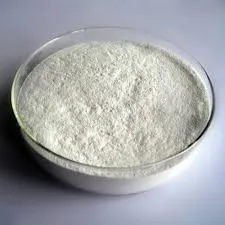
அக் . 08, 2024 21:38 Back to list
Understanding the Uses and Properties of Hydroxypropyl Methyl Cellulose in Various Applications
Understanding Hydroxypropyl Methylcellulose Properties, Uses, and Applications
Hydroxypropyl methylcellulose (HPMC) is a versatile polymer derived from the natural cellulose, primarily used in a variety of applications across multiple industries. Recognized for its unique properties and benefits, HPMC has become a crucial component in pharmaceuticals, construction, food, and cosmetics. This article explores the properties, applications, and significance of HPMC, along with its safety and environmental considerations.
Properties of Hydroxypropyl Methylcellulose
HPMC is a non-ionic, water-soluble cellulose ether formed by the substitution of hydroxyl groups on the cellulose backbone with hydroxypropyl and methoxy groups. The degree of substitution of these groups can significantly affect its solubility, viscosity, and thermal stability. HPMC is available in various grades, characterized by different degrees of hydroxypropyl and methoxy substitutions, making it adaptable to specific requirements.
One notable property of HPMC is its ability to form films and gels, which is important in many applications. Additionally, HPMC exhibits excellent emulsifying and stabilizing properties, making it effective in controlling the texture and consistency of formulations. It is also known for its high viscosity at low concentrations, which is beneficial in creating stable suspensions.
Applications of Hydroxypropyl Methylcellulose
1. Pharmaceuticals HPMC is widely used in the pharmaceutical industry, particularly in the development of controlled-release drug formulations. Its gel-forming abilities allow for prolonged release of active ingredients, enhancing the therapeutic efficacy of medications. Furthermore, HPMC is also employed as a binder in tablet formulations and as a coating agent to improve the stability and appearance of pills.
2. Construction In construction, HPMC is valued for its water-retaining properties and its ability to improve the workability of cement-based formulations. It is commonly added to mortars, plasters, and tile adhesives, enhancing their performance by reducing slippage and increasing adhesion. The water retention capability helps in extending the open time of these materials, ensuring better application and finish.
hydroxypropyl methyl cellulose cas number

3. Food Industry HPMC serves as a food additive in various products, primarily as a thickening agent, emulsifier, and stabilizer. It is often found in low-fat or gluten-free products, where it helps improve texture and mouthfeel. Additionally, HPMC is used in coatings and films for food products, which can extend shelf life and maintain product integrity.
4. Cosmetics and Personal Care In cosmetics, HPMC is utilized as a thickener, emulsifier, and film-forming agent. It enhances the consistency and stability of creams, lotions, and gels, providing a smooth application. Its non-toxic nature and mildness make it suitable for sensitive skin formulations.
Safety and Environmental Considerations
Hydroxypropyl methylcellulose is generally recognized as safe (GRAS) for use in food and pharmaceuticals. Regulatory bodies, including the U.S. Food and Drug Administration (FDA) and the European Food Safety Authority (EFSA), have evaluated its safety, confirming its low toxicity and minimal side effects when used as intended.
From an environmental perspective, HPMC is derived from cellulose, a renewable resource. Its biodegradable properties make it an environmentally friendly alternative to synthetic polymers. However, it is essential to ensure that the production processes of HPMC minimize environmental impact, emphasizing sustainable practices.
Conclusion
Hydroxypropyl methylcellulose is an essential material with a broad spectrum of applications across diverse industries, including pharmaceuticals, construction, food, and personal care. Its unique properties, such as water solubility, emulsification, and film-forming capabilities make it an invaluable ingredient in modern formulations. As industries continue to seek improved performance and sustainability, HPMC stands out as a flexible and eco-friendly choice, reinforcing the importance of cellulose derivatives in today's market. Its safety profile further ensures its continued use in sensitive applications, making HPMC a vital component of contemporary formulations.
-
What is HPMC?
NewsJun.06,2025
-
Understanding Redispersible Powder: The Future of Construction Materials
NewsJun.06,2025
-
Understanding RDP Powder: The Ultimate Solution for Your Construction Needs
NewsJun.06,2025
-
Pure HPMC: The Ideal Solution for Modern Construction and Building Materials
NewsJun.06,2025
-
Methyl Hydroxyethyl Cellulose: A Versatile Chemical Compound
NewsJun.06,2025
-
Hydroxyethyl Cellulose Power: The Essential Chemical for Various Industries
NewsJun.06,2025







